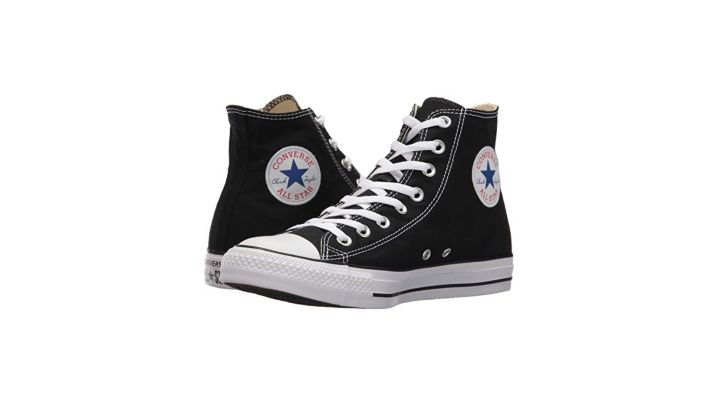We may earn revenue from the products available on this page and participate in affiliate programs.

Buying shoes for CrossFit can be tricky because it’s a sport that involves a variety of running and weightlifting activities. While most athletic shoes are designed for a specific sport, CrossFit shoes need to be all-purpose so you can maximize your WOD (work out of the day). CrossFit shoes provide enough support for running but are also flat enough for lifting. It’s a delicate balance.
In this article, we list the best CrossFit shoes for men (sorry, ladies) and the ways in which we found them. Take a gander and find out which CrossFit shoes are best for you
- Best Overall: Reebok Nano X1
- Best Budget: Converse Chuck Taylor High Tops
- Best Green Materials: Merrell Trail Glove 6
- Best for Wide Feet: Altra Solstice XT 2
- Best for Flat Feet: Inov-8 F-lite 235 V3
Best Overall
Reebok Nano X1
Best Budget
Converse Chuck Taylor High Tops
Best Green Materials
Merrell Trail Glove 6
Best for Wide Feet
Altra Solstice XT 2
Best for Flat Feet
Inov-8 F-lite 235 V3
Things to consider before buying CrossFit shoes for men
Drop
A shoe’s “drop” is the height difference between the shoe’s heel and forefoot, according to shoemaker Salomon. A properly sized shoe drop will match your natural stride. If it doesn’t, the shoe will force an unnatural stride and increase the risk of injury.
Cushion
Cushion can prevent joint and muscle fatigue in your legs, especially on long runs. Lifting weights is a different story. Too much cushion can cause instability during a barbell lift and put you at risk of injury. Too little cushion will make even the shortest of workouts painful. Athletes need to balance their needs.
Arch support
Arch support fills the void between your heel and the ball of your foot. Some people have high arches while others have flat feet. It’s important to know what you have so you can buy footwear that fits you correctly. If you don’t know, Runner’s World magazine has a simple test that only requires wet feet and paper.
FAQs about CrossFit shoes for men
Q: How much do CrossFit shoes cost?
A: The average price for a cross-training shoe is around $80. Premium options built for specific types of functional fitness will typically cost more than $100, while budget options can be found for as low as $40 if you’re a good sale hunter.
Q: Where do I recycle my cross trainers?
A: Each year, about 300 million shoes are thrown in the garbage like a used paper plate after a BBQ, and it’s mostly because people don’t know what else to do. If you want to recycle old shoes, check with cobblers and recycling facilities in your area for programs like Nike’s Move to Zero or TerraCycle ZeroWaste.
Q: What makes CrossFit shoes different from other shoes?
A: Athletic shoes are typically designed for specific activities like running or weightlifting. CrossFit shoes, or cross trainers, are designed to perform adequately for a range of activities. They’re cushioned for repetitive movements like running but also provide a flat base for lifting a barbell.
Q: Are CrossFit shoes worth it?
A: Yes. If you wear running shoes like a Hoka One One, you’d run the risk of getting injured or tweaking a muscle group during the barbell or bodyweight portion of the WOD. On the flip side, you’ll die if you have to run in a powerlifting shoe. Buying a CrossFit shoe is an investment in your long-term functional health.
Q: Are cross-training shoes good for lifting/running?
A: Cross-training shoes are specifically made for both lifting and running. It is sad that this is one of the questions frequently asked, but I’ve read too many questions on Amazon to be surprised.
Q: How do you know if CrossFit shoes fit properly?
A: A CrossFit shoe should fit like most athletic shoes. It should fit snugly in the heel, support your arch, and have extra space in the toe box. Proper fitment will allow your feet to stretch and swell during a workout but not allow excessive movement which causes blisters.
Final thoughts
Selecting the right CrossFit shoes is really a Goldilocks endeavor that requires a precise balance between cushion and stability to meet your personal needs. But by our estimates, you can’t go wrong with the Reebok Nano X1. It fits the bill on every mark.
Methodology
Having personally worn many different brands and styles of sneakers, I started researching this article by looking at the brands I was familiar with. These include Reebok, Adidas, Puma, UnderArmour, and more. I picked out the best each one had to offer and then looked at retailers to see the best shoes that they had to offer, as well.
Next, I removed any shoe on the list that weighed more than 16 ounces, which would feel like a brick on your foot. I excluded shoes with high or regular drops because they would interfere with proper lifting techniques. What remained were shoes with a drop of zero to seven millimeters. After that, I looked for ankle support and cushioning. And finally, I looked to see if they fit any niche categories.
All that reduced the hundreds of options down to the shortlist you’ve read here. As always, we’d love to hear your feedback or stories on our selections in the comments section below.







